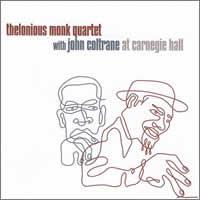Historic Carnegie Hall Performance Uncovered
The time between receiving this and finally writing about it is ludicrous. I’m almost embarrassed to post this in March of 2006. It’s been covered more extensively than most new jazz albums and I wouldn’t be surprised if it outsold most of them as well. On the other hand this music hasn’t been heard in almost 50 years, so what’s a more few months?
You’ve probably heard the story so I’ll keep the details to a minimum: in February of 2005, Library of Congress recording lab supervisor Larry Appelbaum came across some tapes labeled “Carnegie Hall Jazz 1957,” and there he discovered this long-forgotten Carnegie Hall recording of the Thelonious Monk Quartet featuring John Coltrane.
It’s a major find. The group only existed for six months, yet its eighteen-week Five Spot Café run, beginning July 18th, 1957 was legendary—in its own time. A recording was thought not to exist, but around 1960 three studio performances surfaced (with Wilbur Ware on bass, later replaced by Ahmed Abdul-Malik), and they were quickly issued as the Jazzland (Riverside) album Thelonious Monk with John Coltrane .
In his liner notes to that album, Ira Gitler wrote “…those of us who heard (the group at the Five Spot) will never forget the experience.” He “bemoans” the group’s end of 1957 breakup, and found it equally “distressing” that the group had “presumably” not been recorded.
Fortunately, those three tracks were found and because of their rarity, much was made of them, though they were recorded shortly after the group began playing together and Coltrane and Monk had yet to mesh.
So along comes this hitherto unknown recording of the group, playing live, at Carnegie Hall of all places, with Monk at a Steinway, in November of 1957 near the end of the group’s legendary Five Spot Run. Until Mr. Appelbaum found the tape, the legend of the Monk/Coltrane group’s Five Spot performances was kept alive by word of mouth.
Now everyone can hear how the group played downtown, only recorded uptown during a benefit concert for The Morningside Community Center.
As someone whose second jazz album was Monk’s Criss-Cross and whose first was Coltrane’s My Favorite Things, I can say that hearing this for the first time was jolting.
The group played two sets of around 25 minutes each. The first was tighter and more formal, the second looser and more relaxed.
The opener, “Monk’s Mood,” offers a clarity of line, a precise elegance and a confident humor in Monk’s playing that lets you know he’s going to be enjoying the evening.
Locked together on the familiar “Crepuscule With Nellie,” Monk and Coltrane achieve a musical mind-meld that only months of constant performance can produce. They played together the way The Everly Brothers sang back then.
On “Epistrophe,” Coltrane steps out, producing long, complex curling lines, which Monk matches with his own ornate runs punctuated by waterfall-like arpeggios of mind-boggling clarity and tonal perfection. He enjoyed that Steinway!
The second set on side two opens with a loose, almost after the fact “Bye-Ya,” that, unlike the first set, feels as if the quartet is playing more for itself than for the crowd. When Coltrane’s first extended solo elicits applause, the house sounds half-empty. Monk then attacks the piano with odd harmonic percussive thrusts and cascading arpeggios.
A long, churning “Sweet and Lovely” follows, spotlighting the lean efficient, underplaying of both drummer “Shadow Wilson,” and bassist Abdul-Malik, who make the tune get up and walk.
The familiar “Blue Monk” follows, and it is another of the set’s highlights, “bluesier” and more finger snappin’ swinging than on the more familiar studio recordings.
The set ends with an incomplete recording of “Epistrophy,” and then the magic fades out mid-tune and is gone as abruptly as it appeared. When it’s gone you will awake as if from a trance. A time-warp induced trance. How could that music have been made in 1957?
Though this is a “historic” mono recording, the 15IPS tapes have held up remarkably well (they weren’t played, for one thing!) and the mono sound quality is excellent, especially harmonically. Dynamically things are somewhat curtailed, but listen into the recording and there’s great purity, transparency and three dimensionality as well as a fine sense of the Carnegie Hall acoustics. The audience is an afterthought in the recording, and sounds more like the recording of Judy Garland at Carnegie Hall than Belafonte at Carnegie Hall.
Don’t let the CD credits used for the LP issue spook you: the LP lacquer was cut at the Master Cutting Room from the original analog master tapes, not from 24/192 digitally “restored” copies. I have not heard the CD, but one friend said to me, “How can the record still sound that much better?”
Add a 200gram Quiex-SV-P pressing, fine annotation and a beautifully produced paper on cardboard gatefold sleeve and you have a not to be missed release. No wonder it appeared as a “top seller” on most of the online retailers’ websites.
Available through Mosaic Records, www.mosaicrecords.com
Two weeks after this was recorded, Coltrane joined Miles Davis's group, and a year later they convened in Columbia Records’s 30th Street Studios to begin recording Kind of Blue.
- Log in or register to post comments




